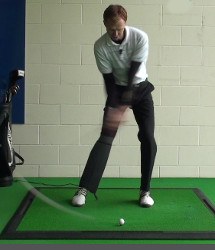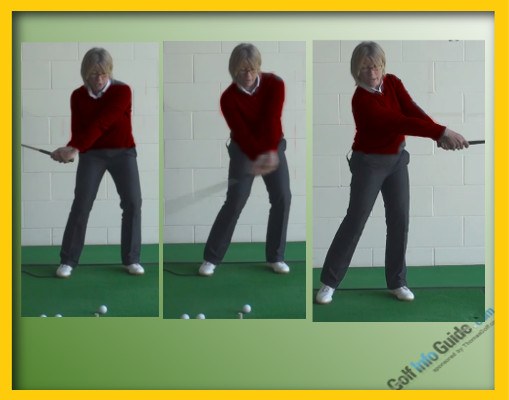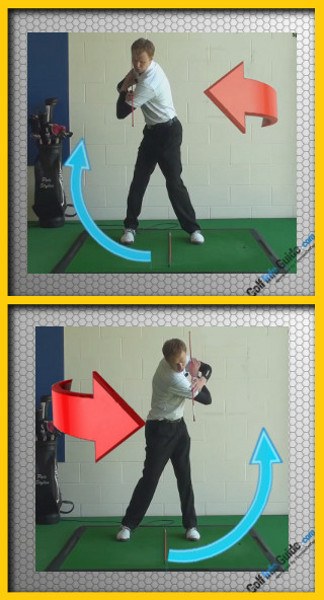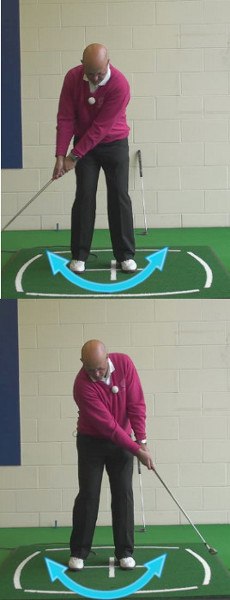
There's a reason very few golfers can hit long irons effectively – a lack of clubhead speed.
The 2-, 3- and 4-irons have long shafts and very little loft. That means the club must be traveling pretty fast in order to bend the shaft and compress the ball against the clubface, delivering sufficient height and spin to stay airborne.
Of course, you've probably replaced your long irons with hybrid clubs by now. If so, you may still struggle to hit your longest remaining iron as far and high as you'd like. Again, too little clubhead speed may be the culprit.
Let's say your longest iron is a 5. Compare your carry distance (not including roll) with the 5-iron to your 7-iron. You should see 20-30 yards of difference between the two clubs. If there's less than 15 yards of difference, consider chucking the 5 and replacing it with an equivalent hybrid.
Another option is to change the shafts in your longer irons. A lighter model, perhaps a graphite shaft, will boost your clubhead speed. It's also possible your current shafts are too stiff. Try dropping from an “S” flex (stiff) to an “R” (regular), or from an “R” to an “A” (senior). This will allow you to better bend the shaft on the downswing, unloading more power into the ball.

These videos will help you understand the nuances of shaft selection:

Irons Flying Too Low – Not Enough Clubhead Speed?
There is a lot to like about high iron shots. When you hit your iron shots high in the sky on the way to the target, the ball will come down softly onto the green, stopping relatively near to where it landed (depending on the condition of the course). When you watch professional golfers play on TV, you will notice that they hit the ball high in the air with their irons throughout the majority of a given round, unless the wind happens to be blowing. In fact, it is the players who can hit their irons the highest that have a distinct advantage over the rest of the field. Hitting the ball high means you can stop the ball quickly, and stopping the ball quickly is one of the best ways to set up short birdie putts.
So, the obvious question is this – how can you hit your irons higher? If it is desirable to hit your irons well up into the sky, you are going to need to know exactly what to work on in order to make that happen. As you probably would guess, this task is not nearly as easy as it might sound. You have to have solid fundamentals in your swing in order to produce a high ball flight that stays on line and leaves your ball near to the hole. Players with good technique and plenty of clubhead speed are most likely to be able to hit the ball as high as desired.
It is the second point in that previous sentence – plenty of clubhead speed – that is going to be the point of this article. There is really no way around it – if you want to hit the ball high with your irons, you are going to need to have enough clubhead speed to get the job done. That isn't to say that you have to swing as fast as the professionals, but you do need to bring at least a fair amount of speed to the hitting area. Many amateur golfers struggle to create speed at impact, and they struggle to get the ball high up into the air as a result.
If you are looking for any possible angle that you can use to improve your overall game, it is certainly worthwhile to attempt to raise the typical ball flight that you use on your iron shots. However, you need to keep perspective on this point as well – you don't want to ruin your swing in the pursuit of a higher ball flight. Yes, a high ball flight is nice with your irons, but you can still play good golf if you keep the ball lower to the ground. In other words, don't go overboard while trying to hit the ball higher. Use the tips provided in the article below to look for a higher flight, but don't make a mess of the rest of your game in the process.
All of the instruction contained below is based on a right handed golfer. If you happen to play left handed, please take a moment to reverse the directions as necessary.

The Relationship Between Clubhead Speed and Trajectory
One of the subtle ways that you can help yourself improve at the game of golf is to improve on your overall understanding of the cause and effect relationships within the game. There are plenty of players on courses all around the world who really don't understand how the game works on a basic level – and that lack of understanding makes it harder for them to improve. By learning a bit about the way the golf ball will respond to your swing, you can take a step forward in your overall ability level on the course.
In this case, the question at hand is simple – why does increasing your clubhead speed cause the ball to fly higher into the air? Well, it all comes down to spin. It is actually the backspin that you put on the golf ball, more than anything else, that causes the ball to lift up into the sky. Shots with a high backspin rate tend to climb quite high, while shots with a low spin rate will stay lower down to the ground on a flatter trajectory. Since shots struck with a higher clubhead speed are going to have more backspin (when all other variables are equal), the correlation is clear – adding clubhead speed will create a higher shot pattern.
It is worth pointing out that this higher-spin game is really only desirable when hitting iron shots – you don't usually want to hit drives with high backspin rates. If you are getting a high rate of backspin with your driver, your tee shots will float high in the air, but they will come down way short of their distance potential. Sure, you are swinging your driver faster than any other club in your bag, but the angle of impact that you use should allow you to keep the spin rate down (provided you have the right equipment for your swing). The combination of relatively low spin on the driver and high spin on the irons is what most professional golfers look for, and you should be looking for the same in your own game.
As you can start to see, adding clubhead speed to your game is something that will benefit you in a number of different ways. Swinging faster should allow you to hit higher iron shots, which will make it easier to get the ball close to the hole. Also, added swing speed will help you to hit the ball farther off the tee, which is always a good thing because that means you will be playing shorter approach shots. To go even another step further, swinging faster will make it easier for you to get your ball out of the deep rough when you do get off track during your round. Any way you look at it, the lesson is simple – adding swing speed to your game is one of the best things you can do to lower your scores.

Other Factors Related to High Iron Shots
Nothing in golf is simple, and that is true in this case as well. Yes, a higher swing speed will help you to hit the ball higher, but there are other factors in this equation which must be considered at the same time. A fast swing alone isn't going to allow you to hit the ball sky-high – you need to hit on the points on the list below in addition to swinging fast in order to see the results you desire.
- Hitting down through impact. This is the most important point related to imparting backspin onto the golf ball – even more important than clubhead speed. If you hit down through the ball aggressively at impact, you will be able to place a high rate on spin on the ball before it leaves the face. Unfortunately, this is something that troubles the average golfer. Many golfers attempt to hit up on the ball, thinking that they need to help the ball get up off the ground. That simply isn't the case. You need to trust that the loft of the club will cause the ball to fly high in the air as long as you hit down properly. Have you ever noticed how professional golfers tend to take large divots when they hit iron shots? That is because they are hitting down through the ball and into the turf. If you are ever going to learn how to hit high and accurate iron shots on a consistent basis, you are going to need to learn how to hit down properly – it's just that simple.
- Using the right ball. In order to get your ball to fly high in the air, you are going to have to make a great swing – and you are going to have to be using the right golf ball. You can pick from a wide range of golf balls when you head to the pro shop to pick up a dozen, and some of the models on the shelves are going to spin more than others. While you don't need to use the highest-spin rate ball available, you should find a model that at least offers a decent spin profile. How can you tell how much spin a ball will offer? Usually, the price of the ball is the best indication. Higher priced golf balls will almost always spin more than lower priced balls, so take a look at the selection at your local store to evaluate your options. For the average golfer, picking out a ball in the middle of the price spectrum is usually a good choice. The cheapest balls aren't going to spin enough to help you hit good shots, but the most-expensive balls will spin too much and will be hard to control. Leave the top-of-the-line balls to the pros and pick something in the middle range to suit your needs nicely.
- Clean grooves. Do you clean out the grooves on your irons between each shot? If not, you should get into that habit right away. The grooves on the face of your irons are going to help the club grab onto the ball at impact, and spin will be generated as a result. However, if your grooves are filled with dirt or grass, they aren't going to be able to be as effective. This is important from any lie, but it is especially important when playing from the rough. To make sure your grooves are clean prior to each shot, do a good job of wiping off the club face of your irons after every swing. Also, give your whole set a quick cleaning prior to starting a round, so that you can be sure each club is ready to go.
- A solid strike. This is one of those points that is extremely important to the goal of playing good golf, yet it is often lost in the discussion of other swing fundamentals. Quite simple, the ability to strike the ball cleanly time after time is one of the biggest keys to playing well. If you can put the ball on the sweet spot of the clubface with regularity, you will be rewarded with solid shots – and likely, with shots that fly high into the air. When you miss the ball out on the toe or in on the heel, you will lose out on potential power and spin, and your shot will not be successful in most cases. To emphasize solid ball striking in your game, focus on balance during practice and make sure you keep your eyes trained on the ball until after impact has taken place.
As you can see, you are going to need to do more than just swing hard if you hope to add height to your iron shots. While working on your game at the driving range, be sure to keep the points on the list above in mind while also working on picking up the pace through the hitting area. If you can manage to increase your swing speed while also hitting on most or all of the points above, higher shots are sure to be in your future.

Finding More Speed
It is easy to say that you want to swing the club at a higher speed, but how do you go about actually making that happen? Do you need to head to the gym, or maybe to the golf shop to buy some new equipment? While both fitness and equipment can play a role in swing speed, there is plenty you can do to improve your power just by refining your technique. A swing with great fundamentals is likely to produce more than enough speed to hit the ball high in the air.
So which fundamentals should you practice to make sure you are getting the most possible speed from your current swing? Make sure to highlight the points below during an upcoming practice session.
- Balance. It might not seem like balance would have much to do with swing speed, but it most certainly does. When you are balanced during your swing, you are free to rotate toward the target as fast as possible on the way down toward impact. It is that aggressive rotation that is going to allow you to produce as much speed as possible through the hitting area. If you are off balance, however, you will always have to hold something back just to make sure you can at least make contact with the ball. An off-balance golf swing is always going to be a tentative swing, and being tentative is no way to hit powerful shots. Always keep balance right up near the top of your priority list and you will be able to swing aggressively through the hitting area while holding nothing back.
- Holding your angle. Aside from balance, there is nothing quite as important to your ability to create swing speed as holding your angle in the downswing. In this case, the 'angle' in question is the angle that is formed between your left arm and the shaft of the club. Ideally, you want to keep this angle at 90* or more for as long as possible in the downswing. Many amateur golfers throw away this angle early in the downswing, and they waste potential swing speed as a result. To work on improving your ability to hold the angle, try to keep your right hand out of the action until as late as possible in the downswing. Pull the club down toward impact with the left hand and only use the right hand to release the club when you are actually delivering the club head into the back of the ball.
- Get to your left side. By the time you make contact with the ball, you should have successfully moved onto your left side with the majority of your weight. It is a common mistake to hang back on the right side in an effort to get the ball up in the air, but that is a move that is only going to cause trouble. From the top of the swing down toward impact, you should be simultaneously rotating and shifting your weight to the left. Great golfers hit the ball while 'posted up' on their left leg, and it should be your goal to do just that. Get onto your left side, keep turning through the shot, and allow the club head to accelerate to its maximum velocity.
- Maximize your shoulder turn. While turning away from the ball early in the swing, you need to make sure that your shoulders keep rotating away from the target as fully as possible. The exact amount that you will be able to rotate will depend on your flexibility and body type, but you should always work to live up to your own potential in this area. A big shoulder turn is going to give you plenty of room to accelerate the club on the way down toward the ball. As a word of warning on this point, you need to make sure you don't force yourself off balance by turning too far – only turn as far as you can while still maintaining your balance properly.
You certainly don't want to destroy your swing technique in the pursuit of added swing speed, but working on the points above should allow you to find more speed while still staying on track for a clean strike. Swing speed is only useful when it is under control, so never cross the line into a reckless swing just to find a few more miles per hour through impact.

Speed in the Short Game
It isn't just useful to be able to hit your irons high when hitting full shots – that skill is also extremely helpful when hitting short game shots. By getting the ball up in the air on a short game shot, you will be able to stop the ball quickly on the putting surface. Stopping the ball is one of the key skills in the short game, and tossing the ball high up into the air over a short distance will permit you to stop the ball even on firm greens.
The challenge of hitting high short game shots is the fact that you need to use plenty of speed – even though you are only a short distance away from the target. Committing to a swing that feels harder-than-necessary can be difficult for the average amateur, but this is a skill that can save you plenty of shots over the course of a typical round. By using the combination of speed and loft on your chip and pitch shots, you can loft the ball gently toward the target where it will stop quickly to set up a short putt.
Professional golfers make these kinds of shots look rather easy, but they are actually quite difficult to execute properly. To pull this shot off with consistent success, the key is going to be practice time – and plenty of it. There is no substitute for experience when trying to loft the ball softly onto the green with a wedge. Include this part of the game in your regular practice sessions and you will quickly become more and more comfortable with this advanced skill.
No matter what club you have in your hands, the ability to put the ball high up into the air is an option that you certainly want to have on your side. You aren't always going to want to hit the ball high, of course – like when you are playing on a windy day – but you do want to have the option at your disposal. Work on the fundamentals of your swing to add as much speed as possible without taking away from your ability to strike the ball cleanly. Even adding just a few feet of height to your typical iron shot will go a long way toward helping you control the ball when it comes down on the green. Good luck!





